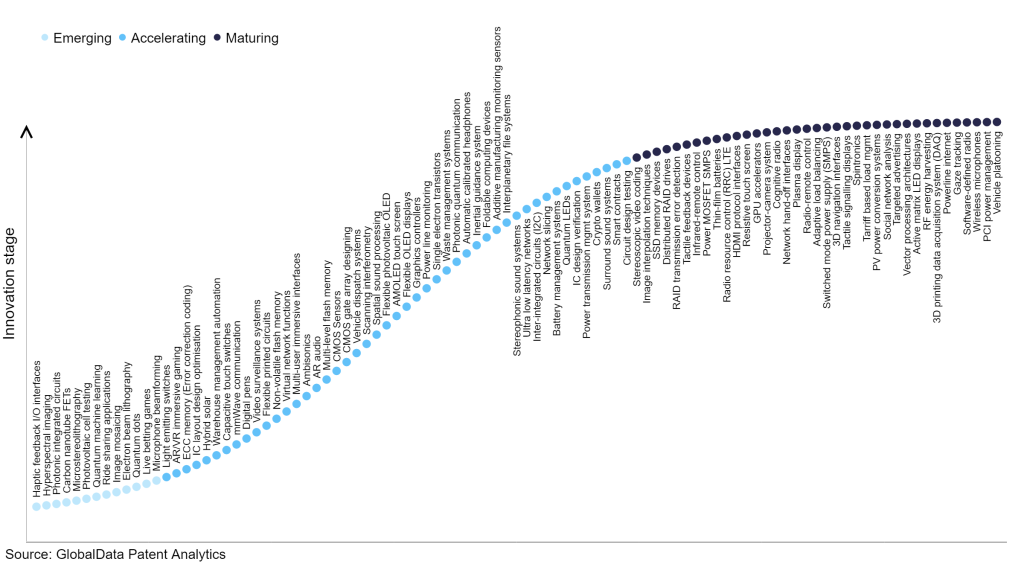The technology industry continues to be a hotbed of innovation, with activity driven by the increasing demand for wireless devices, the need for sustainable and self-powered systems, advancements in RF harvesting technologies, and growing importance of technologies such as antennas, rectifiers, energy storage devices, and power management circuits, which collectively enable the efficient harvesting and utilization of ambient RF energy for various applications such as wireless sensors, Internet of Things (IoT) devices, and wearable electronics. In the last three years alone, there have been over 3.6 million patents filed and granted in the technology industry, according to GlobalData’s report on Technology Innovation: RF energy harvesting. Buy the report here.

Access deeper industry intelligence
Experience unmatched clarity with a single platform that combines unique data, AI, and human expertise.
However, not all innovations are equal and nor do they follow a constant upward trend. Instead, their evolution takes the form of an S-shaped curve that reflects their typical lifecycle from early emergence to accelerating adoption, before finally stabilising and reaching maturity.
Identifying where a particular innovation is on this journey, especially those that are in the emerging and accelerating stages, is essential for understanding their current level of adoption and the likely future trajectory and impact they will have.
300+ innovations will shape the technology industry
According to GlobalData’s Technology Foresights, which plots the S-curve for the technology industry using innovation intensity models built on over 2.5 million patents, there are 300+ innovation areas that will shape the future of the industry.
Within the emerging innovation stage, microphone beamforming, live betting games, and quantum dots are disruptive technologies that are in the early stages of application and should be tracked closely. Circuit design testing, smart contracts, and surround sound systems are some of the accelerating innovation areas, where adoption has been steadily increasing. Among maturing innovation areas are, vehicle platooning, Peripheral Component Interconnect (PCI) power management, and wireless microphones, which are now well established in the industry.
Innovation S-curve for the technology industry

RF energy harvesting is a key innovation area in technology
RF energy harvesting involves capturing and converting electromagnetic energy from the surrounding radio frequency (RF) environment into usable electrical energy, which can be utilized to power low-power electronic devices.
GlobalData’s analysis also uncovers the companies at the forefront of each innovation area and assesses the potential reach and impact of their patenting activity across different applications and geographies. According to GlobalData, there are 190+ companies, spanning technology vendors, established technology companies, and up-and-coming start-ups engaged in the development and application of RF energy harvesting.
Key players in RF energy harvesting – a disruptive innovation in the technology industry
‘Application diversity’ measures the number of different applications identified for each relevant patent and broadly splits companies into either ‘niche’ or ‘diversified’ innovators.
‘Geographic reach’ refers to the number of different countries each relevant patent is registered in and reflects the breadth of geographic application intended, ranging from ‘global’ to ‘local’.
Qualcomm is a leading patent filer in RF energy harvesting. One of the company’s patents describes the device that includes a protective coil to safeguard against unwanted signals. It comprises a first circuit that receives a transmitted signal at a specific frequency and a second circuit that generates a field opposing undesired portions of the signal and other nearby signals at a different frequency.
Other prominent patent filers in the space include Samsung Group and Energous.
By geographic reach, RedWave Energy leads the pack, followed by Masco and TWI. In terms of application diversity, Stryker holds the top position, followed by View and Xylem.
RF energy harvesting is significant as it allows for the conversion of ambient radio frequency signals into usable electrical energy, offering potential solutions for powering low-power electronic devices without the need for traditional power sources. This technology enables greater convenience, energy efficiency, and sustainability in various applications.
To further understand the key themes and technologies disrupting the technology industry, access GlobalData’s latest thematic research report on Technology.
Data Insights
From

The gold standard of business intelligence.
Blending expert knowledge with cutting-edge technology, GlobalData’s unrivalled proprietary data will enable you to decode what’s happening in your market. You can make better informed decisions and gain a future-proof advantage over your competitors.







